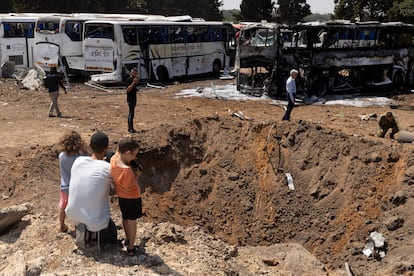Iran finds cracks in Israel’s missile defense system
Despite the estimated effectiveness of 90%, dozens of projectiles launched by Tehran managed to hit densely populated areas of the Jewish state and critical infrastructure such as military or energy facilities
Israel has one of the most sophisticated air defense systems in the world, with an effectiveness rate of around 90%. Since 1992, the law has required buildings to have shelters. All of this is a source of national pride and the envy of countries like Ukraine, which are subjected to constant enemy bombing.
But Iran’s recent attacks have cast doubt on these defense mechanisms. The more than 400 missiles and several hundred drones launched by Tehran in response to the Israeli offensive have caused more than 20 deaths — several of the victims were in their shelters — and significant material damage. Some projectiles reached the heart of the most populated areas, such as Tel Aviv, and hit critical infrastructure such as military installations or the Haifa refinery, where three people died. These are points where the security level is supposed to be at its highest.
Iran is trying to maximize the level of stress on the layered shield system that covers Israeli territory. Despite the Jewish state’s security superiority, Iran’s results indicate that there are cracks through which damage can be inflicted.
Sidharth Kaushal, from the British think tank Royal United Services Institute (RUSI), explained it this way: “One must remember that no system provides preclusive defense and if a system is saturated with enough missiles some will get through. That said, Iran’s success rate is not that high.” According to this expert, the Israeli military has managed to intercept around 90% of the medium-range ballistic missiles launched by Iran since last Friday.
Yehoshua Kalisky, a senior researcher at the Institute for National Security Studies (INSS), understands the Israelis’ “concern” because Iranian missiles are more powerful and also have warheads weighing between 500 and 1,000 kilograms and “exceptional speed and accuracy.” “But we have no reason to worry: we are well protected and are fighting for our survival,” he responded in writing.
As the RUSI expert points out, Iran’s strategy involves massive launches of different types of projectiles designed to overwhelm Israel’s defense capabilities — a modus operandi used daily by the Russian army to overcome Ukrainian air defense batteries: swarms of drones at the forefront to pave the way for missiles to strike when defenses are exhausted.

To strike Israel, Iran requires the use of intermediate-range missiles (1,000 to 3,500 kilometers away). Kaushal mentions two main models: the Shahab-3 and the Emad, which could also include newer types such as the Hajj Qasem and the Fattah-1. All of these missiles can travel faster than the speed of sound and reach Israeli soil in a matter of minutes. They are also ballistic missiles, meaning they travel on a curved trajectory, even exiting the Earth’s atmosphere, to land on their target at greater speeds. This makes detecting and intercepting the missiles very difficult.
The Israeli military has stepped in to try to quell doubts about the effectiveness of home shelters. “Safe rooms remain the safest option and save lives. People losing confidence in them is the worst thing that could happen,” said a military source, according to the Haaretz newspaper. “The Iranian regime is studying how to improve its attack systems. The best way to protect ourselves, for now, is with safe rooms and shelters,” said Dan Poraz, chargé d’affaires at the Israeli Embassy in Spain and the top diplomat in Madrid following the ambassador’s withdrawal during the conflict.
During a meeting with journalists, Poraz said that while any loss of life is a tragedy, he believes the 24 deaths in Israel to be a “very low” figure considering the hundreds of missiles launched by Iran. This, he added, is thanks to Israel’s air defense systems, which he described as “the best in the world,” and to the fact that “people are following safety protocols.”
It is true that so-called safe rooms — with reinforced doors, walls, and windows — and shelters are part of Israeli culture, in a country obsessed with its own defense. However, several people in recent days, specifically in Petah Tikva (near Tel Aviv) and Tamra (near Haifa), have died despite following the protocol and taking cover in these reinforced rooms. “In the event of a direct hit by a ballistic missile with a 500-kilogram warhead traveling at 7,000 kilometers [434 miles] per hour, no shelter is safe,” Kalisky admitted, while adding that “Israeli shelters provide the minimum necessary protection.”

Enrique Cohen, a 23-year-old Mexican in Israel, was wandering early Monday morning near the site where a missile had struck in central Tel Aviv, just minutes after leaving the shelter. “On one hand, you see what’s happening. But on the other, you see the immediate and tremendous response from the authorities, unlike in other countries, and it makes us feel safer. But it’s hard to see that we’re trapped here or to know that something similar could happen tonight. It’s important to follow the instructions of the authorities,” he responded.
Change in alert protocol
Israel changed the protocol for its public alert system on Tuesday after some glitches were reported. Jerusalem residents reported that no alarms were triggered during the morning attack on Tuesday. Until now, the first warning came about half an hour before the projectiles’ arrival, followed by another one and a half minutes before impact via cell phone messages and apps. Now, there will be only a single alert approximately 10 minutes in advance, allowing citizens to prepare to enter shelters.
Ballistic missiles travel the distance from Iran to Israel — between 1,300 and 1,500 kilometers (807 to 942 miles), depending on the target and launch location — in a minimum of 10 to 12 minutes. However, Israel’s security forces’ surveillance systems allow them to anticipate launches. Once a missile wave is declared over, authorities notify the public that the danger level has decreased, and it is safe to come out. This protocol, managed by the Home Front Command (responsible for assisting civilians during attacks and crises) and widely followed by Israelis, has prevented the death toll — currently at 24 — from being higher, authorities acknowledge.
Since 1992, a law has required every residential or commercial building to include a shelter or reinforced room. These spaces are useful in the event of an earthquake or fire, but their primary purpose is to provide protection during missile attacks. Corridors and the underground areas of apartment buildings, hotels, office blocks, government headquarters, educational and healthcare centers, and airports also have areas of greater protection. This regulation, introduced three decades ago under the shadow of threats faced during the Gulf War, emphasized the need for in-home security — which is more accessible than shelters or bunkers in common areas or public buildings.
Over the past 15 years, Israel has been developing a multi-layered air defense system and fine-tuning it as needed. The lowest layer, closest to the ground, is the Iron Dome, which has been in operation since 2011. It intercepts short-range rockets, mortars, and artillery, such as those frequently fired by Hamas and Islamic Jihad from Gaza and by Hezbollah from southern Lebanon.
At the intermediate level is the system known as David’s Sling, which has been operational since 2017. It is designed to intercept ballistic and cruise missiles as well as medium- and long-range rockets.
Finally, at the highest layer, the Arrow system (II and III), also in operation since 2017, is used to intercept missiles that travel even beyond Earth’s atmosphere. These are further reinforced by the Iron Beam system, which uses laser beams and is currently being integrated into the system. In addition to this nationally developed, U.S.-funded defense network, American Patriot and THAAD batteries have also been deployed.
The Iron Dome “is not effective against these types of ballistic missiles” coming from Iran, and they can only be intercepted — and not in all cases — by the Arrow and David’s Sling, Kalisky explains. Kaushal explained: “Interceptor numbers for these [Arrow] systems are unknown but the fact that the U.S. has deployed a destroyer to abet the defense and is apparently considering further deployments would suggest that there is a meaningful risk of Israeli interceptor stockpiles running low.”
Early last Friday morning, Israel launched an offensive aimed primarily at destroying Iran’s nuclear capabilities. Israeli Prime Minister Benjamin Netanyahu estimates that Tehran could acquire the atomic bomb in less than a year. Iran has a far greater attack capability than other groups like Hezbollah or Hamas, and followed through on its promise to respond to Israel’s attack.
The attacks continue, mostly at night and in the early morning, with the launch of hundreds of missiles. The lives of millions of Israelis have been disrupted in a country that remains on high alert — with no commercial flights, no classes, non-essential businesses closed, and a lingering question: how long will this state of uncertainty and threat imposed by war last?
Sign up for our weekly newsletter to get more English-language news coverage from EL PAÍS USA Edition
Tu suscripción se está usando en otro dispositivo
¿Quieres añadir otro usuario a tu suscripción?
Si continúas leyendo en este dispositivo, no se podrá leer en el otro.
FlechaTu suscripción se está usando en otro dispositivo y solo puedes acceder a EL PAÍS desde un dispositivo a la vez.
Si quieres compartir tu cuenta, cambia tu suscripción a la modalidad Premium, así podrás añadir otro usuario. Cada uno accederá con su propia cuenta de email, lo que os permitirá personalizar vuestra experiencia en EL PAÍS.
¿Tienes una suscripción de empresa? Accede aquí para contratar más cuentas.
En el caso de no saber quién está usando tu cuenta, te recomendamos cambiar tu contraseña aquí.
Si decides continuar compartiendo tu cuenta, este mensaje se mostrará en tu dispositivo y en el de la otra persona que está usando tu cuenta de forma indefinida, afectando a tu experiencia de lectura. Puedes consultar aquí los términos y condiciones de la suscripción digital.
More information
Archived In
Últimas noticias
Maduro pleads not guilty before the federal court in New York: ‘I am still the president of Venezuela’
A new test can detect Alzheimer’s from a finger prick
UN team enters Sudanese city of El Fasher after paramilitary massacre: ‘It’s like a ghost town’
A recipe for resistance: Indigenous peoples politicize their struggles from the kitchen
Most viewed
- Gilles Lipovetsky: ‘If you want to live better and fall in love, take Prozac, don’t look to philosophy’
- Alain Aspect, Nobel laureate in physics: ‘Einstein was so smart that he would have had to recognize quantum entanglement’
- Alvin Hellerstein, a 92-year-old judge appointed by Bill Clinton, to preside over Maduro’s trial in New York
- Maduro’s downfall puts China’s relationship with Venezuela to the test
- Why oil has been at the center of Venezuela-US conflicts for decades









































